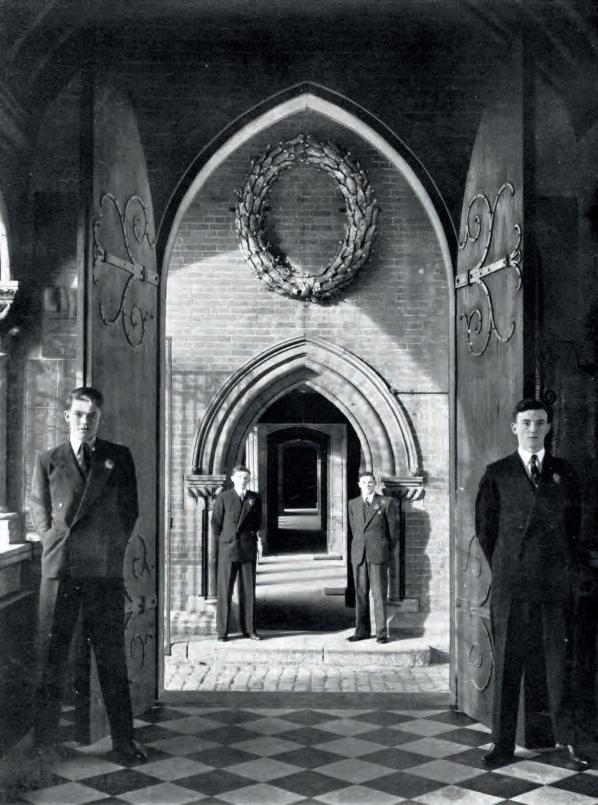
4 minute read
Archive News
Buying treats at Grubbies, 1950s
THE WELLINGTON DECADES PROJECT
Advertisement
What was everyday life like for Wellingtonians in the past? What did they think of their living conditions and the food they ate? How did they react to school rules, fagging, and daily Chapel? Which teachers made a lasting impression on them? What were the highlights of the school year?
No-one can answer these questions better than the students themselves, and so in the spring of 2020 we launched the Wellington Decades Project. By inviting Old Wellingtonians to respond to a questionnaire and send in their memories, we want to build up a rich historical resource, allowing historians of the future an in-depth picture of the Wellington ‘student experience’ during the second half of the 20th century.
So far, we have concentrated on those who left College up to and including 1961. Around 550 OWs – all of those for whom we have contact details – have been invited to participate, and more than 150 have responded. College Archivist Caroline Jones is now compiling their recollections, which provide a remarkable insight into College life in the 1940s and 1950s – entirely fascinating, often amusing and sometimes eye-opening.

Leaving Chapel, 1951 Top: Fag’s tea, 1944 Bottom: Divinity class, 1955


Major ‘Mac’ Mackenzie, accompanied to the Chemistry lab by his faithful dog which would lick up any spilt chemicals
Most OWs of this era considered conditions at College to have been at least adequate, although many remembered being cold in winter, and some mentioned obligatory cold baths! Many recalled that the privacy afforded by their individual cubicles or ‘tishes’ was quite unusual in schools at the time, and much appreciated. In an era dominated by rationing, most thought that the school had done well to feed them on the limited resources available. Responses were very evenly split between those who remembered being ‘always’ or ‘often’ hungry, and those who said they never were! We received many accounts of how the Dining Hall fare was supplemented by snacks cooked up on the ‘brew rings’ in the dormitories – bacon, eggs, beans, porridge, and on one occasion, squirrel! Grubbies was a favourite too, for treats such as biscuits, ice cream (pink or white), and milkshakes, but most remembered that consumption had been limited by the extent of their pocket money. Fagging was very much a part of life at 1950s Wellington. Overwhelmingly, students accepted it as such, and very few felt that it had been abused. All remembered taking the ‘fag exam’ to learn useful facts about the College in their first term. Few candidates failed, but one who did was compelled to climb onto the bar between the ‘tishes’ on the first floor and sing a song’ as penance! Corporal punishment was also routine and accepted by most, although several OWs recalled particular instances when they had felt their punishment was unfair.
Many of our respondents felt that Wellington in the post-war years was not a particularly academic place, but a few teachers stood out, inspiring intellectual curiosity or a passion for their subject. More were memorable for their idiosyncrasies, including Major ‘Mac’ Mackenzie, accompanied to the Chemistry lab by
his faithful dog which would lick up any spilt chemicals; Anthony Crawley with his archaic ‘Oxford English’ diction; and the chaplain, Dudley Dinnis, who would spend most lessons producing elaborate and beautiful coloured chalk drawings on the blackboard. We also received descriptions of the ingenious methods devised by the boys to disconcert or distract their teachers, thus relieving the monotony of the lessons.
The Second World War obviously had a big impact on life at Wellington and we have received some wonderful accounts of the war years from our oldest OWs. Their successors, by contrast, mostly felt that they had not been particularly aware of the events of the outside world. One exception to this was the funeral of King George VI, as members of the Corps were invited to line the route for his coffin as it processed to Windsor Castle. Many OWs vividly remember preparing for this by learning to ‘reverse arms,’ a tricky manoeuvre especially for smaller boys whose rifle was as big as they were.
Once the reminiscences have been compiled and edited, they will form the core of a new Wellington College Heritage website, to be launched in the Autumn. We do hope that many OWs will enjoy browsing the site and stimulating memories of their own. For those who are not online, we will be finding other ways of sharing the results of our project.
The Dining Hall, 1957


Physics class in Lecture Theatre, 1955

Life in the Hill corridor, by Bryan de Grineau, 1952
In 2022 we will be contacting those who were students here in the 1960s, a decade famed for revolutions in society and popular culture, and we look forward to reading how (if at all!) those changes were felt at Wellington.










